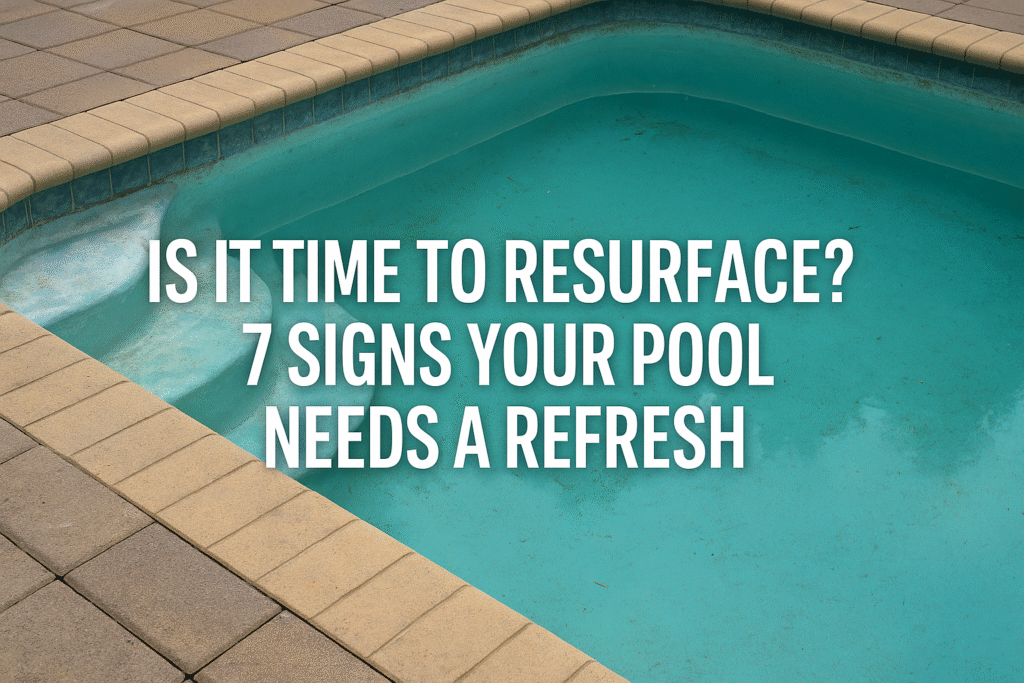Your pool may look fine at a glance, but just like a home roof or driveway, it won’t last forever without upkeep. Over time, exposure to sun, chemicals, and water movement gradually wears down a pool’s surface. Knowing when to resurface your pool is key to avoiding larger repairs, safety hazards, and higher long-term costs.
If you’re unsure whether it’s time, here are 7 clear signs your pool needs resurfacing, plus what to expect from the process and how professional Houston pool maintenance services can help.
1. Stains That Won’t Go Away
Some staining is cosmetic, but persistent, dark stains often signal deeper issues. Metal, algae, and chemical buildup can embed into plaster, causing discoloration that resists even aggressive cleaning.
- What it means: Surface degradation or chemical imbalance
- Solution: Resurfacing allows you to start fresh with stain-resistant materials like quartz or pebble finishes
2. Rough or Etched Surfaces
Run your hand along the pool walls or floor. If it feels rough, pitted, or sandpaper-like, your plaster has likely begun to erode. This can irritate skin and damage swimwear.
- What it means: Acid wash damage, age, or imbalanced pH
- Solution: Resurfacing smooths the surface and restores a safe, skin-friendly finish
3. Cracks or Flaking (Spalling)
Visible cracks on the floor or walls could be superficial, or structural. Flaking or chipping plaster (known as spalling) is common in older pools, especially those exposed to freeze-thaw cycles or hard water.
- What it means: Loss of adhesion or age-related breakdown
- Solution: Resurfacing helps prevent water intrusion and further damage to the shell
4. Constant Leaks
A leak isn’t always due to plumbing. Sometimes, tiny cracks or worn surfaces allow water to escape slowly and silently, leading to rising water bills and chemical loss.
- What it means: Deteriorated surface integrity
- Solution: Before resurfacing, pros inspect for leaks and repair the shell as part of the process
5. Fading or Discoloration
Is your once-sparkling blue pool now a dull gray? UV rays, chemicals, and age gradually bleach out the original color of plaster or paint.
- What it means: Oxidation and wear
- Solution: Choose modern finishes in long-lasting hues like pebble or hydrazzo that resist fading
6. Frequent Chemical Imbalance
Older pool surfaces often require more chemical adjustment. If you’re constantly tweaking chlorine or pH just to keep things stable, the surface may be part of the problem.
- What it means: The surface is reacting with chemicals, throwing off balance
- Solution: Resurfacing with neutral materials can make water chemistry easier to maintain
7. It’s Been 10+ Years
Most traditional plaster finishes last 7 to 10 years with proper maintenance. If your pool is older and hasn’t been resurfaced in over a decade, you’re likely overdue, even if there are no obvious defects yet.
- What it means: Surface at end-of-life
- Solution: Schedule an assessment with a reputable Houston pool maintenance provider
What Happens During Pool Resurfacing?
Pool resurfacing typically follows these steps:
- Drain the Pool: Water is removed and safety measures are taken.
- Chip Out Old Plaster: Technicians remove the existing surface.
- Structural Patching: Cracks are filled, and any damage is addressed.
- Surface Application: New material, plaster, quartz, pebble, is sprayed and hand-finished.
- Curing and Refilling: The pool cures over several days before being refilled and chemically balanced.
Most projects take 5 to 10 days, depending on size and material.
FAQs
How long does a resurfaced pool last?
It depends on the material. Plaster lasts 7 to 10 years, quartz can last 10 to 15, and pebble finishes often last 15 to 20 years with proper care.
Can I resurface my pool myself?
While DIY kits exist, resurfacing is a major job that requires specialty tools, knowledge, and safety gear. Improper work can void warranties and cause expensive issues.
Is resurfacing the same as replastering?
Yes, in most cases. “Resurfacing” is the general term, while “replastering” specifically refers to applying new plaster. Other resurfacing materials include quartz, pebble, or tile.
Does resurfacing fix leaks?
Not always. If the leak is due to plumbing, resurfacing won’t solve it. However, it does repair minor surface cracks and often includes shell patching before applying the new finish.
How much does it cost to resurface a pool in Houston?
Prices range from $4,500 to $10,000+ depending on pool size, material, and labor. Always get quotes from licensed professionals in Houston pool maintenance for accuracy.
Final Thoughts
Your pool’s surface isn’t just about looks, it’s about safety, performance, and longevity. Resurfacing is one of the most valuable investments you can make as a pool owner. If you’ve noticed any of the signs above, now is the time to act. A fresh surface doesn’t just protect your pool, it transforms it into a clean, inviting retreat.
Work with an experienced Houston pool maintenance team to assess your pool and explore modern resurfacing materials that suit your aesthetic, lifestyle, and budget.


